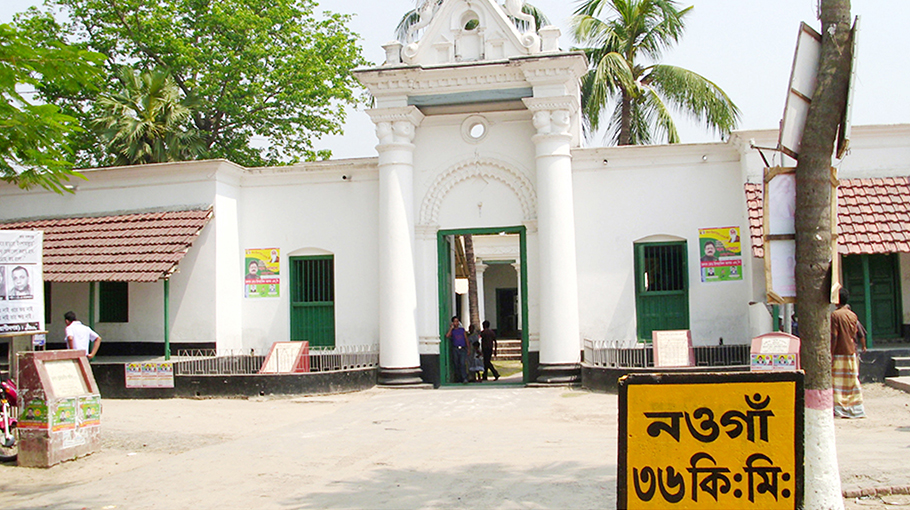Naogaon in festive mood marking Tagore’s birth anniv

Patisar Kuthibari of world poet Rabindranath Tagore is situated on the banks of Nagar River in Atrai upazila of Naogaon. Rabindranath Tagore first came to Patisar in 1891 to look after the zamindari of Kaligram Pargana, which was obtained from ancestral sources. Although he came to see and hear the zamindari, he then worked for the people of the neglected Patisar area, including establishing charitable hospitals and educational institutions. He set up an agricultural bank here with the Nobel Prize money of 1 lakh 8 thousand Taka for the welfare of the farmers.
Celebrating the birth anniversary of Rabindranath Tagore, a festive environment has been seen in the region with adjacent upazilas which were the part of the zamindari, supervised by Rabindranath Tagore himself. Marking his birth anniversary, villages of Bogura and Natore districts adjoining Patisar have already become festive with the programmes and fairs. Relatives from far and wide have come to visit almost every house in these villages. Different types of food are being arranged at home. Patisar covers a large part of the poet's literary creation. Sitting in Patisar, Rabindranath Tagore wrote innumerable books including Chitra, Purnima, Sandhya, Gora, Ghare-Baire. Rabindranath visited Patisar for the last time on 27 July 1937. Patisar Kuthibari still stands with the memory of Rabindranath in its bosom. The Department of Archeology took charge of the mansion in 1990. In 1830, Rabindranath's grandfather Dwarkanath Tagore incorporated the Kaligram Pargana zamindari into the Purchasutra. Patisar is the headquarters of Kaligram Pargana. Kaligram Pargana consists of 600 villages in Naogaon, Bogura and Natore districts. Its area was 230 square miles. Ratwal and Bhandargram were two more sub-kacharis. Kaligram Pargana was bounded on the north by Malshan Adamdighi, on the south by Atrai River, on the east by the west bank of Nagar River and on the west by Nagar Bidhaut Banka-Kashiabari village. The Tagore family of Jorasanko in Calcutta had 3 zamindari in Bangladesh. The arrival of Rabindranath Tagore in Patisar was not intentional, much luckily. When Satyendra's son Surendranath was asked to choose his favorite part between Birahimpur and Kaligram Parganas at the end of Ejmali property, he liked Birahimpur then naturally came to Rabindranath's part and then Kaligram Pargana whose headquarters is Patisar. 'Fascinated by the devotion and respect of the common people of Kaligram. By coming here he was able to come very close to the farmers. This gave birth to a good idea about the economic relations of the farmers. Rabindranath had a deep love for Patisar and also for the people here. He undertook various developmental programs in the underdeveloped parganas including road and ghat education, healthcare and poverty alleviation. The program included rural education, health, agro-industry, establishment of banks, construction of roads, digging of wells, lakes and ponds, clearing of forests, rural arbitration system and protection of poor people from the interest of moneylenders. To implement these programs, the pargana was divided into three sections. Kaligram formed an organization called "Hitaishi Sabha". To enlighten the people of Kaligram Pargana in the light of education, in 1913 he established 3 Middle English (ME) schools in Patisar, Ratowal and Kamata and 3 high schools in the name of his son Rathindranath in Patisar. The first name of Kaligram Rathindranath Institution located at Patisar was Patisar ME School. The school was later converted into a high school in 1938. It was the third high school in Naogaon district. In January 1913, a school was established in Ratwal division and another school was established in Kamata.
The founder of the institutions is Rabindranath Tagore himself. It would not be an exaggeration to say that Rabindranath really rediscovered himself when he came to East Bengal to do zamindari. While sitting in Patisar, he got the material to write Gora and Ghare Bahire (special part) novels, short stories 'Pratihinsa' and Thakurda.
He wrote many poems like Purnima, Sandhya, Chaitali-Madhyahan, Palligram, Samanya Lok, Durlabh Janma, Kheya, Karma, Meghdoot, Didi, Parichay, Anantapath. He composed some heart touching songs like Bidhi Dagar Ankhi, Jale Dob Chikon Shyamal, Tumi Nabarupe Eso Prante.




